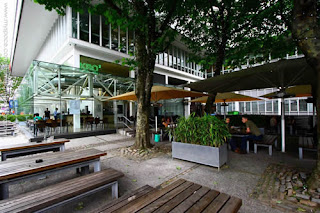
This one is right on our south-eastern boundary with the Mancunian Way almost passing Oxford Road overhead, but what a great, albeit ultra-modern, bar Kro2 is. Almost entirely made from glass, this ground floor bar is sister to
Kro Piccadilly and a number of other Kros around Manchester [1]. It's usually very busy when we amble past towards gigs at the Academy, but as well as catering for the obvious student customers, this place also attracts those who like proper beer. Four real ales and a real cider were on along with a very impressive list of Danish craft beers. The cask ales were standards - Bombardier, Deuchar's, Wainwright's and TT Landlord - but were priced well under three quid.
As for them Danish craft beers:
- Rise Brewery: Rise IPA (5.5%, £5.95), Aero Grolle Pilsner (4.8%), Aero King Arthur Stout (6.0%) and Aero Valnodde Ol No.5 (7.0%), all £4.95.
- Orbaek Brewery: Dark Horse, Fynsk Forar, OPA and Peach Beer (all 5.0% and £3.95).
- Sogaard Brewery: Jumfuhumle (4.8%), Loa (5.3%), Klosterbryg (5.5%) and Red Quinta (4.5%), all £3.95. (All available at discount, with occasional freebies apparently, at the Kro Beer Club.)
Fine food is a boast of Kros but doesn't really interest us; still, the menu looks to be a good mix of traditional classics and modern nonsense and portions always seen generous. A word for the friendly staff as well, including a personal reminder to each table of drinkers that last orders were approaching. A regular mini-beer festival is held at Kro2 in the large beer garden [2], which overlooks the delightful views of Europe's busiest bus route (the Oxford Road corridor which ferries untold numbers of students and commuters to and from town, the Universities and South Manchester suburbs such as Rusholme, Withington and Didsbury). Kro2 is another good real ale establishment at this end of town, and it's encouraging to see a modern, student-focussed bar selling such decent beers.






















.jpg)


























